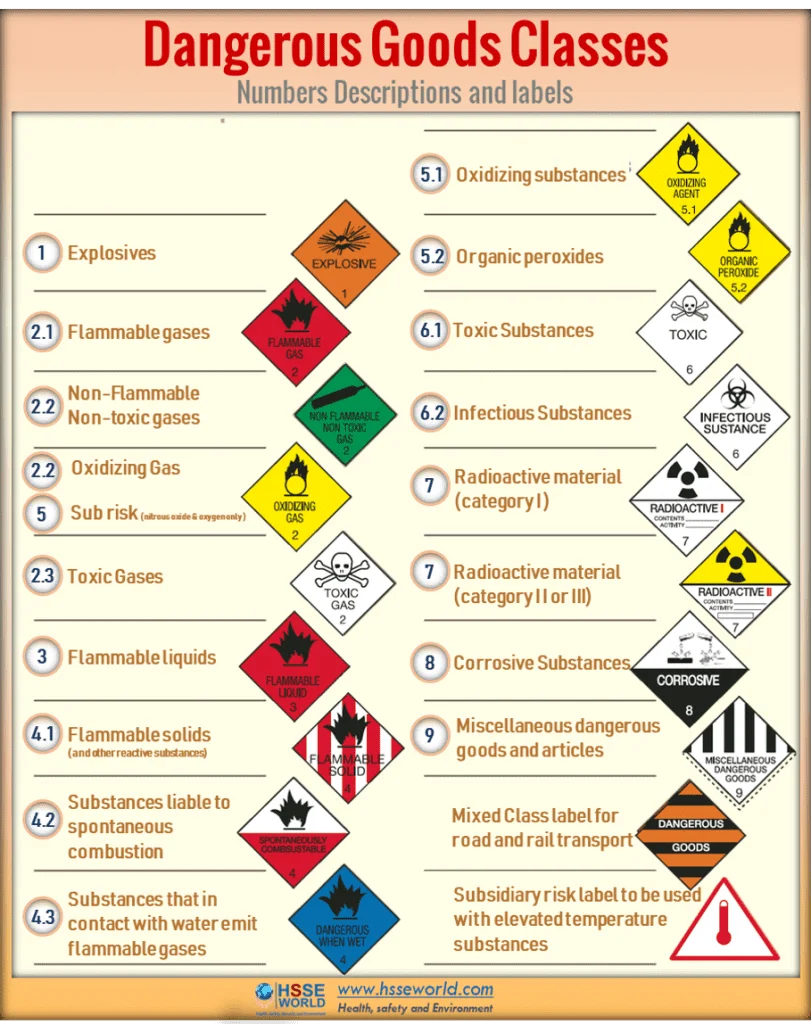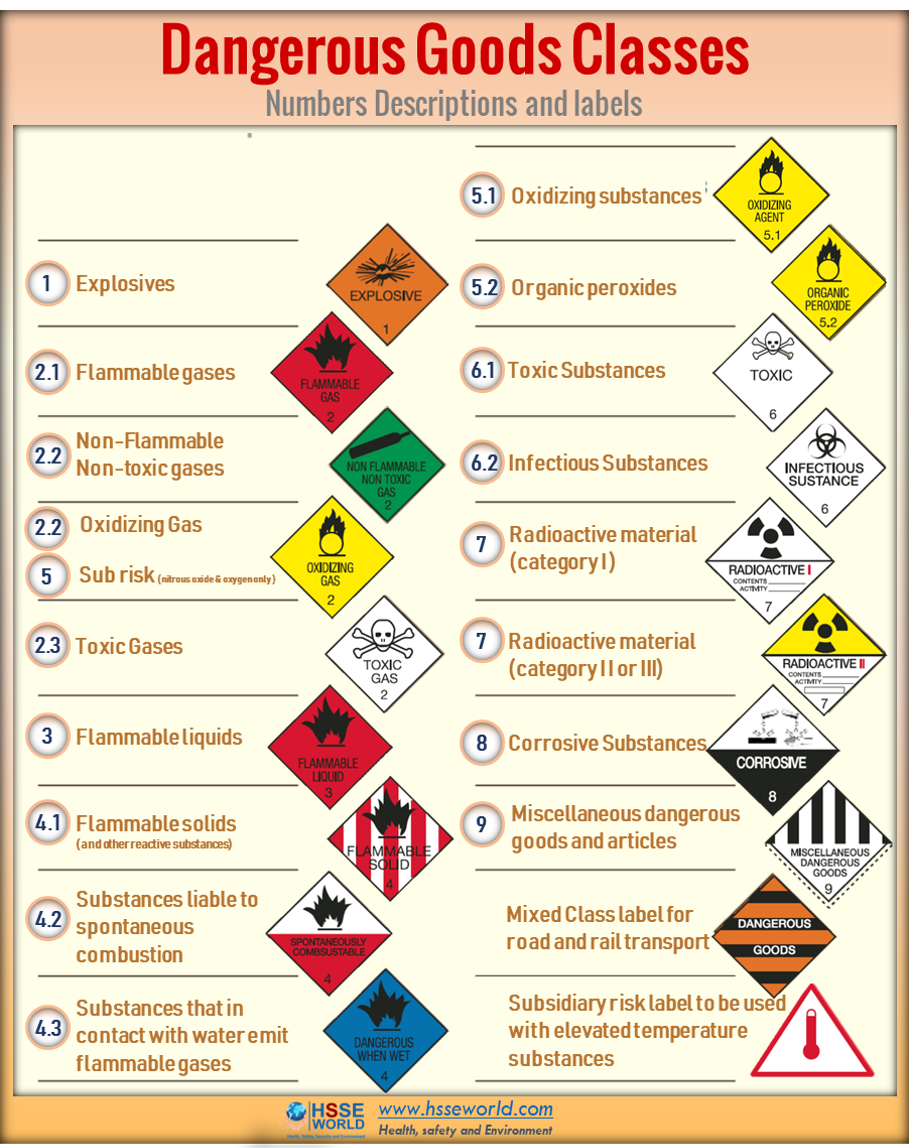Dangerous goods are materials or items with hazardous properties which, if not properly controlled, present a potential hazard to human health and safety, infrastructure, and/ or their means of transport.
The transportation of dangerous goods is controlled and governed by a variety of different regulatory regimes, operating at both the national and international levels. Prominent regulatory frameworks for the transportation of dangerous goods include the United Nations Recommendations on the Transport of Dangerous Goods, ICAO’s Technical Instructions, IATA’s Dangerous Goods Regulations, and the IMO’s International Maritime Dangerous Goods Code. Collectively, these regulatory regimes mandate the means by which dangerous goods are to be handled, packaged, labeled, and transported.
Regulatory frameworks incorporate comprehensive classification systems of hazards to provide a taxonomy of dangerous goods. Classification of dangerous goods is broken down into nine classes according to the type of dangerous materials or items present, click on a class to read more details;

Class 1 – Explosives
Explosives are materials or items which have the ability to rapidly conflagrate or detonate as a consequence of chemical reaction.
DGI is proficient in handling explosives, Class 1 Dangerous Goods. DGI have the ability to service all customer requests pertaining to the logistics of explosives; packing, packaging, compliance, freight forwarding, and training.
Reason for Regulation
Explosives are capable by chemical reaction of producing gases at temperatures, pressures, and speeds as to cause catastrophic damage through force and/or of producing otherwise hazardous amounts of heat, light, sound, gas, or smoke
Sub-Divisions
Division 1.1: Substances and articles which have a mass explosion hazard
Division 1.2: Substances and articles which have a projection hazard but not a mass explosion hazard
Division 1.3: Substances and articles which have a fire hazard and either a minor blast hazard or a minor projection hazard or both
Division 1.4: Substances and articles which present no significant hazard; only a small hazard in the event of ignition or initiation during transport with any effects largely confined to the package
Division 1.5: Very insensitive substances which have a mass explosion hazard
Division 1.6: Extremely insensitive articles which do not have a mass explosion hazard
Commonly Transported Explosives
Ammunition/cartridges, Fireworks/pyrotechnics, Flares, Blasting caps/detonators, Fuse, Primers, Explosive charges (blasting, demolition, etc), Detonating cord, Airbag inflators, Igniters, Rockets, TNT / TNT compositions, RDX / RDX compositions, PETN / PETN compositions.
Class 2 – Gases
Gases are defined by dangerous goods regulations as substances that have a vapor pressure of 300 kPa or greater at 50°c or which are completely gaseous at 20°c at standard atmospheric pressure, and items containing these substances. The class encompasses compressed gases, liquefied gases, dissolved gases, refrigerated liquefied gases, mixtures of one or more gases with one or more vapors of substances of other classes, articles charged with a gas, and aerosols.
DGI is proficient in handling gases, Class 2 Dangerous Goods. DGI have the ability to service all customer requests pertaining to the logistics of gases; packing, packaging, compliance, freight forwarding, and training.
Reason for Regulation
Gases are capable of posing serious hazards due to their flammability, potential asphyxiants, ability to oxidize, and/or their toxicity or corrosiveness to humans.
Sub-Divisions
Division 2.1: Flammable gases
Division 2.2: Non-flammable, non-toxic gases
Division 2.3: Toxic gases
Commonly Transported Gases
Aerosols, Compressed air, Hydrocarbon gas-powered devices, Fire extinguishers, Gas cartridges, Fertilizer ammoniating solution, Insecticide gases, Refrigerant gases, Lighters, Acetylene / Oxyacetylene, Carbon dioxide, Helium/helium compounds, Hydrogen/hydrogen compounds, Oxygen/oxygen compounds, Nitrogen/nitrogen compounds, Natural gas, Oil gas, Petroleum gases, Butane, Propane, Ethane, Methane, Dimethyl ether, Propene/propylene, Ethylene.
Class 3 – Flammable Liquids
Flammable liquids are defined by dangerous goods regulations as liquids, mixtures of liquids or liquids containing solids in solution or suspension which give off a flammable vapor (have a flashpoint) at temperatures of not more than 60-65°C, liquids offered for transport at temperatures at or above their flash point or substances transported at elevated temperatures in a liquid state and which give off a flammable vapor at a temperature at or below the maximum transport temperature.
DGI is proficient in handling flammable liquids, Class 3 Dangerous Goods. DGI has the ability to service all customer requests pertaining to the logistics of flammable liquids; packing, packaging, compliance, freight forwarding, and training.
Reason for Regulation
Flammable liquids are capable of posing serious hazards due to their volatility, combustibility, and potential in causing or propagating severe conflagrations.
Sub-Divisions
There are no subdivisions within Class 3, Flammable Liquids.
Commonly Transported Flammable Liquids
Acetone/acetone oils, Adhesives, Paints/lacquers/varnishes, Alcohols, Perfumery products, Gasoline / Petrol, Diesel fuel, Aviation fuel, Liquid biofuels, Coal tar/coal tar distillates, Petroleum crude oil, Petroleum distillates, Gas oil, Shale oil, Heating oil, Kerosene, Resins, Tars, Turpentine, Carbamate insecticides, Organochlorine pesticides, Organophosphorus pesticides, Copper-based pesticides, Esters, Ethers, Ethanol, Benzene, Butanols, Dichloropropenes, Diethyl ether, Isobutanols, Isopropyls, Methanol, Octanes.
Class 4 – Flammable Solids; Spontaneous Combustibles; ‘Dangerous When Wet’ Materials
Flammable solids are materials that, under conditions encountered in transport, are readily combustible or may cause or contribute to fire through friction, self-reactive substances which are liable to undergo a strongly exothermic reaction or solid desensitized explosives. Also included are substances that are liable to spontaneous heating under normal transport conditions, or to heating up in contact with air, and are consequently liable to catch fire and substances which emit flammable gases or become spontaneously flammable when in contact with water.
DGI is proficient in handling flammable solids, Class 4 Dangerous Goods. DGI has the ability to service all customer requests pertaining to the logistics of flammable solids; packing, packaging, compliance, freight forwarding, and training.
Reason for Regulation
Flammable solids are capable of posing serious hazards due to their volatility, combustibility, and potential in causing or propagating severe conflagrations.
Sub-Divisions
Division 4.1: Flammable solids
Division 4.2: Substances liable to spontaneous combustion
Division 4.3: Substances which, in contact with water, emit flammable gases
Commonly Transported Flammable Solids; Spontaneous Combustibles; ‘Dangerous When Wet’ Materials
Alkali metals, Metal powders, Aluminium phosphide, Sodium batteries, Sodium cells, Firelighters, Matches, Calcium carbide, Camphor, Carbon, Activated carbon, Celluloid, Cerium, Copra, Seed cake, Oily cotton waste, Desensitized explosives, Oily fabrics, Oily fibers, Ferrocerium, Iron oxide (spent, Iron sponge/direct-reduced iron (spent), Metaldehyde, Naphthalene, Nitrocellulose, Phosphorus, Sulphur.
Class 5 – Oxidizers; Organic Peroxides
Oxidizers are defined by dangerous goods regulations as substances that may cause or contribute to combustion, generally by yielding oxygen as a result of a redox chemical reaction. Organic peroxides are substances that may be considered derivatives of hydrogen peroxide where one or both hydrogen atoms of the chemical structure have been replaced by organic radicals.
DGI is proficient in handling oxidizing agents and organic peroxides, Class 5 Dangerous Goods. DGI have the ability to service all customer requests pertaining to the logistics of oxidizing agents and organic peroxides; packing, packaging, compliance, freight forwarding, and training.
Reason for Regulation
Oxidizers, although not necessarily combustible in themselves, can yield oxygen and in so doing cause or contribute to the combustion of other materials. Organic peroxides are thermally unstable and may exude heat whilst undergoing exothermic autocatalytic decomposition. Additionally, organic peroxides may be liable to explosive decomposition, burn rapidly, be sensitive to impact or friction, react dangerously with other substances or cause damage to the eyes.
Sub-Divisions
Division 5.1: Oxidizing substances
Division 5.1: Organic peroxides
Commonly Transported Oxidizers; Organic Peroxides
Chemical oxygen generators, Ammonium nitrate fertilizers, Chlorates, Nitrates, Nitrites, Perchlorates, Permanganates, Persulphates, Aluminium nitrate, Ammonium dichromate, Ammonium nitrate, Ammonium persulphate, Calcium hypochlorite, Calcium nitrate, Calcium peroxide, Hydrogen peroxide, Magnesium peroxide, Lead nitrate, Lithium hypochlorite, Potassium chlorate, Potassium nitrate, Potassium chlorate, Potassium perchlorate, Potassium permanganate, Sodium nitrate, Sodium persulphate.
Class 6 – Toxic Substances; Infectious Substances
Toxic substances are those which are liable either to cause death or serious injury or to harm human health if swallowed, inhaled, or by skin contact. Infectious substances are those which are known or can be reasonably expected to contain pathogens. Dangerous goods regulations define pathogens as microorganisms, such as bacteria, viruses, rickettsiae, parasites, and fungi, or other agents which can cause disease in humans or animals.
DGI is proficient in handling toxic and infectious substances, Class 6 Dangerous Goods. DGI have the ability to service all customer requests pertaining to the logistics of oxidizing agents and organic peroxides; packing, packaging, compliance, freight forwarding, and training.
Reason for Regulation
Toxic and infectious substances can pose significant risks to human and animal health upon contact.
Sub-Divisions
Division 6.1: Toxic substances
Division 6.2: Infectious substances
Commonly Transported Toxic Substances; Infectious Substances
Medical/Biomedical waste, Clinical waste, Biological cultures/samples/specimens, Medical cultures/samples/specimens, Tear gas substances, Motor fuel anti-knock mixture, Dyes, Carbamate pesticides, Alkaloids, Allyls, Acids, Arsenates, Arsenites, Cyanides, Thiols/mercaptans, Cresols, Barium compounds, Arsenic / arsenic compounds, Beryllium/ beryllium compounds, Lead compounds, Mercury compounds, Nicotine/nicotine compounds, Selenium compounds, Antimony, Ammonium metavanadate, Adiponitrile, Chloroform, Dichloromethane, Hexachlorophene, Phenol, Resorcinol.
Class 7 – Radioactive Material
Dangerous goods regulations define radioactive material as any material containing radionuclides where both the activity concentration and the total activity exceeds certain pre-defined values. A radionuclide is an atom with an unstable nucleus and which consequently is subject to radioactive decay.
DGI is proficient in handling radioactive material, Class 7 Dangerous Goods. DGI has the ability to service all customer requests pertaining to the logistics of radioactive material; packing, packaging, compliance, freight forwarding, and training.
Reason for Regulation
Whilst undergoing radioactive decay radionuclides emit ionizing radiation, which presents potentially severe risks to human health.
Sub-Divisions
There are no subdivisions within Class 7, Radioactive Material.
Commonly Transported Radioactive Material
Radioactive ores, Medical isotopes, Yellowcake, Density gauges, Mixed fission products, Surface contaminated objects, Caesium radionuclides / isotopes, Iridium radionuclides / isotopes, Americium radionuclides / isotopes, Plutonium radionuclides / isotopes, Radium radionuclides / isotopes, Thorium radionuclides / isotopes, Uranium radionuclides / isotopes, Depleted uranium / depleted uranium products, Uranium hexafluoride, Enriched Uranium.
Class 8 – Corrosives
Corrosives are substances that by chemical action degrade or disintegrate other materials upon contact.
DGI is proficient in handling corrosives, Class 8 Dangerous Goods. DGI has the ability to service all customer requests pertaining to the logistics of corrosives; packing, packaging, compliance, freight forwarding, and training.
Reason for Regulation
Corrosives cause severe damage when in contact with living tissue or, in the case of leakage, damage or destroy surrounding materials.
Sub-Divisions
There are no subdivisions within Class 8, Corrosives.
Commonly Transported Corrosives
Acids/acid solutions, Batteries, Battery fluid, Fuel cell cartridges, Dyes, Fire extinguisher charges, Formaldehyde, Flux, Paints, Alkylphenols, Amines, Polyamines, Sulphides, Polysulphides, Chlorides, Chlorosilanes, Bromine, Cyclohexylamine, Phenol/carbolic acid, Hydrofluoric acid, Hydrochloric acid, Sulfuric acid, Nitric acid, Sludge acid, Hydrogen fluoride, Iodine, Morpholine.
Class 9 – Miscellaneous Dangerous Goods
Miscellaneous dangerous goods are substances and articles which during transport present a danger or hazard not covered by other classes. This class encompasses, but is not limited to, environmentally hazardous substances, substances that are transported at elevated temperatures, miscellaneous articles and substances, genetically modified organisms and micro-organisms, and (depending on the method of transport) magnetized materials and aviation regulated substances.
DGI is proficient in handling miscellaneous dangerous goods, Class 9 Dangerous Goods. DGI has the ability to service all customer requests pertaining to the logistics of miscellaneous dangerous goods; packing, packaging, compliance, freight forwarding, and training.
Reason for Regulation
Miscellaneous dangerous goods present a wide array of potential hazards to human health and safety, infrastructure, and/ or their means of transport.
Sub-Divisions
There are no subdivisions within Class 9, Miscellaneous Dangerous Goods.
Commonly Transported Miscellaneous Dangerous Goods
Dry ice/cardice / solid carbon dioxide, Expandable polymeric beads/polystyrene beads, Ammonium nitrate fertilizers, Blue asbestos/crocidolite, Lithium-ion batteries, Lithium metal batteries, Battery-powered equipment, Battery-powered vehicles, Fuel cell engines, Internal combustion engines, Vehicles, Magnetized material, Dangerous goods in apparatus, Dangerous goods in machinery, Genetically modified organisms, Genetically modified micro-organisms, Chemical kits, First aid kits, Life-saving appliances, Airbag modules, Seatbelt pre-tensioners, Plastics molding compound, Castor bean plant products, Polychlorinated biphenyls, Polychlorinated terphenyls, Dibromodifluoromethane, Benzaldehyde.
Download Infographic
Dangerous Goods Classes
More Photos
- What are the Best Practices for Managing Subcontractor Risk
- Photo of the day: 10 Essential Safety Tips for Driving in Hot Weather Conditions
- Photo of the day: best workplace safety tips
- Photo of the day: The Importance of Stop Work Authority in Maintaining Workplace Safety
- Photo of the day: Tomorrow’s Reward for Working Safely Today: Cultivating a Culture of Safety
- Photo of the day: Preventing slips and trips at work
- Photo of the day: Learn the DRSABCD action Plan
- Working with Electricity Electrical Accidents Guide for Electrical Workers
- Photo of the day: Hearing Protection Device Selection
- Photo of the day: If An Earthquake Shakes You-Infographic free
- Fire Safety Posters Free Download
- Photo of the day: First Aid for Electrical Burns-Infographic free
- Infographic: First Aid for Cuts and Scrapes free download
- Photo of The day: Work Safe with Lasers-Laser Safety free
- Photo of the day: Working Safely with chemicals and chemical Management
- Photo of the day: Safe work practices when using MEWPs ( updated)
- Photo of the day: Preventing Common Kitchen Hazards
- Photo of the day: Safe handling of Gas Cylinders and lecture bottles
- Photo of the day: Forklift Stability Triangle
- Photo of the day: Defective Tools Safe Work Practice
- Photo of the day: Lift With Your Legs Not With Your Back
- Photo of the day: First Aid for burns
- Photo of the day: The 7 Principles of HACCP
- Photo of the day: Working Safely with Suspended Loads
- Photo of the day: Heat Stroke First Aid and safety posters
- Photo of the day: Near-Miss Reporting and Posters
- Photo of the day: Ergonomic chair and office chair safety tips
- Photo of the day: Whole Body Vibration
- Photo of the day: Substation Safety Equipment
- Photo of the day: Bypassing Safety Controls Rules
- Photo of the day: Lightning Safety Tips
- Photo of the day: Overhead Power lines Clearance
- Photo of the day: Floor Marking
- Photo of the day: Types of Foot Protection
- Photo of the day: Types of Hand Protection
- Photo of the day: Lockout and Tagout Safety
- Photo of the day: Fall Protection Plans
- Photo of the day: Flood Safety Tips
- Photo of the day: Read All Labels Work safe
- Photo of the day: Run Project safely with Crane Hand Signals
- Photo of the day: Flagman and Traffic control
- Photo of the day: Managing Risks of Exposure to Solvents in the workplace
- Photo of the day: Scissor Lift Safety
- Photo of the day: HSE Bulletin Board
- Photo of the day: Arc-Fault Circuit Interrupters (AFCI)
- Photo of the day: Safe use of ladders and step ladders
- Photo of the day: Concrete Truck Driver Hand Signals
- Photo of the day: Extension Cord Safety Tips
- Photo of the day: Protect your Head
- Photo of the day: choosing the right Anchorage
- Photo of the day: Work-Related Asthma
- Photo of the day: Top FIVE Heavy Equipment Construction Site Safety Tips
- Photo of the day: sun safety in the workplace
- Photo of the day: Cannabis and Impairment in the Workplace
- Photo of the day: Position for safety and comfort-Safety Tips
- Photo of the day: Generator Safety
- Photo of the day: Controlling COVID-19 in the Workplace-Physical Barriers
- Photo of the day: Manual Material handling
- Photo of the day: Personal Protective Equipment last resort
- Photo of the day: WHMIS 2015 – Pictograms
- Photo of the day: Indoor Air Quality
- Photo of the day: Noise in the affected workplace
- Photo of the day: Fatigue at Work
- Photo of the day: Don’t be Driven to Distraction
- Photo of the day: working in heat and Humidex Rating
- How to use Plate Clamps Safely: Safety Moment#34
- Photo of the day: Sitting at work
- Photo of the day: 5 ways to reduce the risk of Slipping and Tripping
- Photo of the day: Preventing the spread of contagious illness
- Photo of the day: Incident Investigations
- Photo of the day: 10 Scaffold Safety Essentials
- Photo of the day: Effective Health and Safety Committees
- Photo of the day: New worker Orientation & Safety Orientation checklist
- Photo of the day: Workplace Inspection
- Photo of the day: musculoskeletal disorders
- Photo of the day: Emergency preparedness in the workplace
- Photo of the day: Mental health in the workplace
- Photo of the day: Trenching Safety Tips That Can Save a Life
- Photo of the day: Dangerous Goods Classes
- Photo of the day: Safety Equipment for Confined Spaces
- Photo of the day: Tips to reduce Heat stress in the workplace
- Photo of the day: hierarchy of controls
- Your steps to chemical safety
- H2S Gas and how to handle its Emergency
- Photo of the day: Importance of Mock drill and Fire Action Emergency Procedure
- Photo of the day: Choosing the Right Face Mask and the difference between a respirator and face mask
- Photo of the day: Confined space safety Precautions
- Breath Safely: The Proper Use of Respiratory Protection
- Photo of the day: Electric shock survival
- Photo of the day: Chemical Spill Emergency Response
- Photo of the day: Construction Site fire Safety




